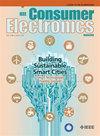On the Performance of Consumer IoT Networks Based on Asynchronous Cell-Free Massive MIMO
IF 4.3
2区 计算机科学
Q1 ENGINEERING, ELECTRICAL & ELECTRONIC
引用次数: 0
Abstract
The proliferation of consumer electronics in the Internet of Things (IoT) has led to the expanding applications in various fields with increasing demand for large-scale connections. Spectrum scarcity has become a crucial challenge. Cell-free (CF) massive multiple-input multiple-output (mMIMO) is a promising technology to support the future consumer IoT networks due to its ability to assure seamless mobility support. However, a perfect synchronization has been commonly assumed in the CF mMIMO system which is infeasible in the consumer IoT networks where the intelligent devices and access points (APs) can be geographically distributed. This paper considers an asynchronous CF mMIMO system for the consumer IoT networks and investigates its performance. A rate-splitting (RS) strategy is proposed and the phase shift is considered in the line of sight (LoS) path of Rician fading channel with mobility and phase noise. The phase-aware minimum mean square error (MMSE) and non-perceptual linear MMSE (LMMSE) estimators are derived. The closed-form expressions of downlink spectral efficiency (SE) for coherent and non-coherent data transmission are derived for the system with and without RS strategy. Simulation results demonstrate that the proposed RS strategy can improve the downlink SE of the consumer IoT networks based on asynchronous CF mMIMO.基于异步无小区大规模MIMO的消费物联网网络性能研究
随着消费电子产品在物联网(IoT)中的普及,随着对大规模连接的需求不断增加,物联网在各个领域的应用也在不断扩大。频谱短缺已成为一个重大挑战。无蜂窝(CF)大规模多输入多输出(mMIMO)是一项很有前途的技术,可以支持未来的消费者物联网网络,因为它能够确保无缝移动支持。然而,在CF mMIMO系统中通常假设完美的同步,这在智能设备和接入点(ap)可以地理分布的消费者物联网网络中是不可实现的。本文研究了一种用于消费物联网网络的异步CF mMIMO系统,并对其性能进行了研究。提出了一种分频策略,并在考虑迁移性和相位噪声的梯度衰落信道视距路径中考虑相移问题。给出了相位感知最小均方误差(MMSE)估计和非感知线性最小均方误差(LMMSE)估计。推导了采用RS策略和不采用RS策略时系统相干和非相干数据传输下行频谱效率的封闭表达式。仿真结果表明,所提出的RS策略可以提高基于异步CF mimo的消费物联网网络的下行链路SE。
本文章由计算机程序翻译,如有差异,请以英文原文为准。
求助全文
约1分钟内获得全文
求助全文
来源期刊
CiteScore
7.70
自引率
9.30%
发文量
59
审稿时长
3.3 months
期刊介绍:
The main focus for the IEEE Transactions on Consumer Electronics is the engineering and research aspects of the theory, design, construction, manufacture or end use of mass market electronics, systems, software and services for consumers.

 求助内容:
求助内容: 应助结果提醒方式:
应助结果提醒方式:


